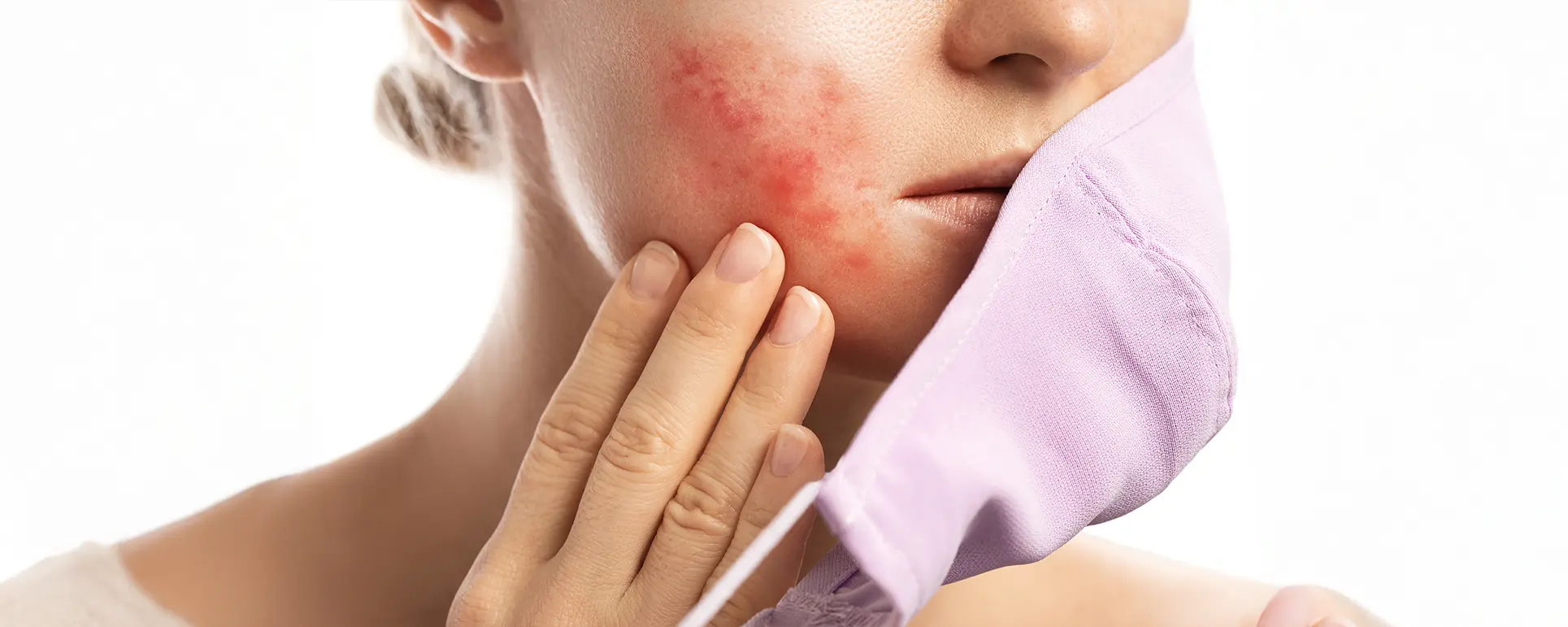Having sensitive skin can feel like walking through a minefield. You try a new moisturiser and suddenly your face is red and stinging. Even products labelled “gentle” or “for sensitive skin” sometimes leave you with burning, itching, or unexpected flare-ups. For many people, this becomes a daily struggle constantly second-guessing which products are safe and which ones might trigger an unwanted reaction.
If this sounds familiar, you’re not alone. Sensitive or reactive skin is a common concern, and it often leads to frustration and confusion. Why does your skin react so strongly, even to products that seem harmless? Is it an allergy? A skin condition? Or something in your environment?
In this article, we’ll dive deep into what might be causing your skin to act out from common culprits like rosacea and contact dermatitis to less obvious triggers like over-cleansing or environmental factors. We’ll also explore how a dermatologist can play a vital role in diagnosing your specific condition, identifying triggers, and tailoring treatments to help calm and strengthen your skin over time.
Whether you’ve been struggling for years or just recently noticed your skin becoming more reactive, understanding the underlying cause is the first step toward lasting relief. And with the right guidance, personalised care, and professional insight, you can finally get your skin back on track.
What Is Sensitive Skin?
Sensitive skin isn’t a medical diagnosis in itself, but rather a term used to describe skin that is easily irritated by factors that wouldn’t normally affect others. It refers to a heightened reaction to various external or internal triggers such as skincare products, weather changes, environmental pollutants, or even stress and hormonal fluctuations. People with sensitive skin often experience a range of uncomfortable symptoms that can interfere with their daily skincare routine and quality of life.
Common symptoms of sensitive skin include:
- Redness or flushing – The skin may become visibly red or blotchy, especially on the cheeks, nose, or chin.
- Burning or stinging sensations – These reactions can occur immediately after applying skincare products, particularly those with fragrances, alcohol, or active ingredients.
- Dryness or tightness – Sensitive skin often struggles to maintain its natural moisture barrier, leading to a dry, tight feeling throughout the day.
- Flaky or rough patches – In more severe cases, the skin may peel or develop textured, uneven areas that can be difficult to treat without causing further irritation.
- Itching or discomfort – A persistent or sudden itchiness, even in the absence of visible irritation, is a hallmark of sensitive skin.
For many individuals, these symptoms can appear with little warning and without a clear cause. Even products labelled as “gentle,” “hypoallergenic,” or “for sensitive skin” can sometimes provoke reactions, making it increasingly difficult to identify what’s truly safe to use. This unpredictability can make skincare feel like a frustrating guessing game.
It’s also important to note that sensitive skin is not exclusive to the face. It can occur anywhere on the body scalp, neck, hands, and even the chest and may flare up differently depending on the location. Moreover, the severity of sensitivity can fluctuate over time. What once worked for your skin might suddenly begin to cause irritation, especially as your skin changes due to age, weather, hormones, or new habits.
Because the term “sensitive skin” covers such a wide range of symptoms and triggers, getting an expert opinion from a dermatologist is often the most effective first step toward managing it properly.
Common Conditions That Cause Sensitive, Reactive Skin

If your skin seems to react to almost everything whether it’s weather, water, skincare products, or even stress it could be more than just “sensitive skin.” Several underlying dermatological conditions can cause the skin to become highly reactive and uncomfortable. Understanding these conditions is the first step toward getting the right diagnosis and treatment.
Below are some of the most common skin conditions associated with heightened sensitivity and reactivity:
1. Rosacea
Rosacea is a chronic inflammatory skin condition that primarily affects the central area of the face, including the cheeks, nose, forehead, and chin. It’s often mistaken for acne or general redness, but it has its own distinct features and triggers.
While the exact cause of rosacea remains unknown, it is believed to involve a combination of genetic, environmental, and immune system factors. People with rosacea typically have very sensitive skin that can flare up in response to common environmental or lifestyle triggers.
Key Symptoms of Rosacea:
- Persistent redness (erythema) in the central portion of the face that may look like blushing or flushing.
- Visible blood vessels (telangiectasia) that appear as tiny red lines or broken capillaries on the skin.
- Papules and pustules, which resemble acne but lack blackheads and often occur alongside redness.
- Burning, stinging, or itching sensations when applying even mild skincare products.
- Skin sensitivity to common triggers, including:
- Heat and sun exposure
- Spicy foods or hot drinks
- Alcohol, particularly red wine
- Stress and physical exertion
- Skincare products with alcohol, fragrance, or strong active ingredients
Rosacea tends to be a progressive condition that can worsen over time if not managed properly. Many people with rosacea find it challenging to build a skincare routine that doesn’t irritate their skin, which is why medical intervention is often necessary. A dermatologist can help confirm the diagnosis and offer tailored treatments to calm inflammation, strengthen the skin barrier, and minimise visible redness.
2. Contact Dermatitis
Contact dermatitis is a common cause of sensitive, reactive skin and occurs when the skin comes into direct contact with a substance that causes irritation or triggers an allergic reaction. This condition results in inflammation of the skin, which can range from mild redness and dryness to severe blistering and swelling.
There are two main types of contact dermatitis:
- Irritant Contact Dermatitis (ICD): This is the more common type and happens when the skin is repeatedly exposed to harsh substances that damage the outer protective barrier. Examples include soaps, detergents, solvents, and even water if exposure is prolonged.
- Allergic Contact Dermatitis (ACD): This form occurs when the immune system reacts to a specific allergen, even in small amounts. Common culprits include nickel (found in jewellery), fragrances, preservatives in skincare products, latex, and certain plants like poison ivy.
Because symptoms can appear hours or even days after exposure, it’s not always obvious what’s causing the reaction. Repeated exposure can make the skin more reactive over time, creating a cycle of irritation that becomes difficult to break without intervention.
Key Symptoms of Contact Dermatitis:
- Red, inflamed patches that may appear dry, rough, or cracked.
- Intense itching or burning, especially around the area of contact.
- Blisters or weeping sores, particularly in more severe cases or with prolonged exposure.
- Swelling or tenderness in the affected area.
- Skin thickening or scaling with chronic exposure to irritants or allergens.
Contact dermatitis can occur anywhere on the body but is especially common on the hands, face, neck, and areas that come into frequent contact with personal care products or environmental irritants.
Because the list of potential irritants and allergens is so broad, diagnosing the cause on your own can be challenging. A dermatologist can conduct patch testing to identify specific allergens or guide you in eliminating likely triggers. They can also recommend barrier-repair skincare products and prescribe topical treatments like corticosteroids or calcineurin inhibitors to reduce inflammation and speed up healing.
Left untreated, contact dermatitis can become chronic, leading to persistent dryness, thickened skin, and increased sensitivity over time. That’s why professional evaluation is essential for managing the condition effectively.
3. Atopic Dermatitis (Eczema)

Atopic dermatitis commonly known as eczema is a chronic inflammatory skin condition that causes the skin to become dry, itchy, and easily irritated. It’s particularly common in children but can affect people of all ages. For those with eczema, the skin’s natural protective barrier doesn’t function as effectively, making it more vulnerable to irritants, allergens, and environmental stressors.
Eczema is part of what’s known as the “atopic triad,” which includes asthma and hay fever. Many individuals with eczema also have one or both of these conditions, or a family history of allergic disease.
Unlike temporary rashes, eczema is long-lasting and tends to flare up periodically. These flare-ups may be triggered by things like:
- Changes in temperature or humidity (especially cold, dry air)
- Harsh soaps, detergents, or fragranced products
- Certain fabrics, such as wool or synthetic fibres
- Stress or lack of sleep
- Food allergens or environmental allergens like dust mites or pollen
Because the skin is constantly dry and inflamed, it becomes more reactive over time, leading to increased sensitivity to products that may otherwise be well-tolerated.
Key Symptoms of Eczema:
- Itchy, inflamed skin – Intense itching is a hallmark symptom and can become so severe that it disrupts sleep or daily life.
- Dry, scaly patches that can feel rough and may crack or bleed when scratched.
- Redness and swelling, especially during flare-ups.
- Thickened, leathery skin (known as lichenification) in areas where scratching is frequent.
- Rashes commonly found:
- In the creases of the elbows and behind the knees
- On the face, especially in infants
- On the hands, neck, or wrists in older children and adults
Over time, repeated scratching can damage the skin further, increasing the risk of infections and making the condition even more difficult to control.
Eczema can significantly impact your quality of life not just due to physical discomfort, but also because of the social or emotional stress that comes with visible rashes or flare-ups. A dermatologist can help by developing a tailored treatment plan that may include:
- Prescription moisturisers and barrier creams
- Topical corticosteroids or non-steroid anti-inflammatories
- Antihistamines to manage itch
- Lifestyle recommendations to avoid known triggers
- In more severe cases, phototherapy or oral medications to control inflammation
How a Dermatologist Diagnoses and Treats Sensitive Skin

When your skin seems to react to everything from the weather to your moisturiser it can be hard to know where to turn. That’s where a dermatologist comes in. Rather than continuing to guess which products or habits are causing problems, a dermatologist can help pinpoint the underlying issue, rule out more serious conditions, and guide you toward real, lasting relief.
Here’s a breakdown of what you can typically expect during your visit and how a dermatologist might approach diagnosing and treating sensitive or reactive skin:
1. Comprehensive Skin Evaluation
The first step is a thorough evaluation of your skin. Your dermatologist will carefully examine the affected areas, looking for specific patterns of irritation, inflammation, or damage that may offer clues about the underlying cause.
During this consultation, they’ll also take a detailed medical history, including:
- When your symptoms first started
- Whether they come and go or persist over time
- Any previous diagnoses or treatments you’ve tried
- Your family history of skin conditions (like eczema, rosacea, or psoriasis)
They’ll also ask about your daily skincare routine, the types of products you’re using, and whether you’ve recently introduced anything new such as serums, exfoliants, laundry detergents, or even dietary supplements. Lifestyle factors like stress levels, diet, sleep habits, and environmental exposures (e.g. cold air, pollution) will also be considered, as they often play a role in triggering or worsening skin sensitivity.
2. Patch Testing for Allergies
If your dermatologist suspects that your sensitivity might be caused by contact dermatitis, they may recommend patch testing. This is a specialised diagnostic tool used to identify whether your skin is reacting to specific allergens or irritants.
The process involves applying small, diluted samples of potential allergens to adhesive patches, which are then placed on your back or arm for 48–72 hours. After the patches are removed, your skin is assessed for signs of redness, swelling, or other reactions.
Patch testing can reveal common sensitivities to:
- Fragrances or preservatives in skincare
- Nickel in jewellery or clothing fasteners
- Latex or rubber materials
- Hair dyes and nail products
- Sunscreen ingredients
- Certain essential oils or botanicals
By identifying these triggers, your dermatologist can help you avoid problematic ingredients and reduce unnecessary flare-ups.
3. Ruling Out Other Skin Conditions
Sometimes what seems like sensitive skin is actually an underlying chronic skin condition in disguise. Dermatologists are trained to spot the subtle differences between conditions that often mimic one another.
They may consider and rule out conditions such as:
- Rosacea – particularly if redness, flushing, or visible blood vessels are present
- Atopic dermatitis (eczema) – especially if there’s a history of allergies or asthma
- Seborrheic dermatitis – if oily areas like the scalp or sides of the nose are involved
- Perioral dermatitis – a type of facial rash around the mouth, nose, or eyes
In rare or complex cases, your dermatologist may perform a skin biopsy a simple procedure where a small sample of skin is removed for lab analysis to confirm a diagnosis and rule out more serious conditions like autoimmune diseases or infections.
4. Creating a Personalised Treatment Plan
Once a clear diagnosis has been made, your dermatologist will develop a tailored treatmentplan designed to reduce irritation, calm inflammation, and restore your skin’s natural barrier.
Treatment strategies may include:
- Topical treatments
These might include corticosteroid creams, non-steroidal anti-inflammatory ointments, antihistamines to reduce itching, or barrier-repair creams to soothe and protect compromised skin. - Oral medications
In more severe cases such as widespread eczema, stubborn rosacea, or allergic skin reactions oral medications may be prescribed. These can include antibiotics, antihistamines, or, in select cases, immunosuppressants. - Prescription skincare products
Dermatologists may recommend prescription cleansers and moisturisers formulated without known irritants, plus calming agents like ceramides, niacinamide, or colloidal oatmeal. These help strengthen the skin barrier and reduce reactivity over time. - Lifestyle and skincare routine changes
A dermatologist can also guide you in making small but impactful changes to your lifestyle and habits, such as:
- Avoiding known environmental and product-based triggers
- Choosing pH-balanced, fragrance-free skincare
- Reducing over-washing and avoiding hot water
- Managing stress levels, which can worsen inflammation
- Simplifying your routine to reduce ingredient overload
This holistic, individualised approach is often the most effective way to break the cycle of irritation and restore calm, healthy skin.
Tips to Prevent Sensitive Skin Flare-Ups
Once you’ve consulted with a dermatologist, there are also some general skincare practices you can follow to reduce sensitivity:
- Use Gentle, Fragrance-Free Products: Opt for skincare products that are designed for sensitive skin. Avoid products that contain alcohol, fragrances, or harsh chemicals that can irritate the skin.
- Moisturise Regularly: Keep your skin hydrated to support its barrier. Look for moisturisers with ceramides, hyaluronic acid, or glycerin.
- Avoid Hot Water: Hot water can strip your skin of natural oils and exacerbate sensitivity. Wash with lukewarm water instead.
- Wear Sunscreen: Sensitive skin is often more prone to sun damage. Use a broad-spectrum SPF 30 or higher daily, even in winter.
- Identify and Avoid Triggers: Work with your dermatologist to identify specific triggers for your skin reactions, whether it’s certain products, foods, or environmental factors.
Final Thought: Taking Control of Your Sensitive Skin
Sensitive skin that reacts to everything can be frustrating, but a dermatologist can help you pinpoint the cause and create a treatment plan that works. Whether it’s rosacea, contact dermatitis, or eczema, managing sensitive skin is possible with the right care and guidance.
You can get in touch with us to book a consultation with one of our expert dermatologists in London. We offer personalised care to help you manage your skin’s sensitivity, restore comfort, and bring balance to your skincare routine.
References:
- Duarte, I. et al. (2017) ‘Sensitive skin: review of an ascending concept’, International Journal of Dermatology, 56(9), pp. 900–906. Available at: https://www.ncbi.nlm.nih.gov/pmc/articles/PMC5595600/
- Escalas‑Taberner, M. et al. (2019) ‘Diagnosis and Treatment of Sensitive Skin Syndrome’, Actas Dermo‑Sifiliográficas, 110(4), pp. 310–321. Available at: https://www.actasdermo.org/en-diagnosis-treatment-sensitive-skin-syndrome-articulo-S1578219019303075
- Adler, B.L. and Frances, J. (2025) ‘Allergic contact dermatitis revisited: a comprehensive review’, JAAD Reviews, in press. doi: 10.1016/j.jaadrev.2025.00038. https://www.jaadreviews.org/article/S2950-1989%2825%2900038-8/fulltext?utm_source=chatgpt.com
- Erdogan, H.K. et al. (2018) ‘The evaluation of contact sensitivity with standard and cosmetic patch test series in rosacea patients’, Annals of Dermatology, 30(3), pp. 290–295. Available at: https://pubmed.ncbi.nlm.nih.gov/29853742/
- Patel, K. (2022) ‘Irritant contact dermatitis a review’, Current Dermatology Reports, 11(3), pp. e51–e59. Available at: https://link.springer.com/article/10.1007/s13671-021-00351-4?utm_source=chatgpt.com
